Family name: Papaveraceae Jussieu
Synonym(s): Chelidoniaceae Martinov; Eschscholziaceae Ser.; Fumariaceae Marquis, nom. cons.; Hypecoaceae Willk. & Lange; Platystemonaceae Rchb. ex Lilja; Pteridophyllaceae Nakai ex Reveal & Hoogland
Common name(s): poppy family
*Number of genera/species: 48/775
List of genera records in GRIN-Global
Fruit usually a capsulecapsule:
a dry, dehiscent fruit derived from a compound ovary , rarely inflated, valvate, poricidalporicidal:
, rarely inflated, valvate, poricidalporicidal:
type of capsular dehiscence, fruit opening by pores or flaps (often near the top)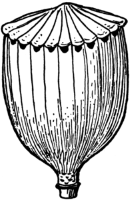 , or transversetransverse:
, or transversetransverse:
lying, situated, or placed across
dehiscence. Or, sometimes a loment, acheneachene:
a dry, indehiscent, one-seeded fruit, with seed attached to pericarp at a single point, derived from a single, superior, simple or compound, one-loculed ovary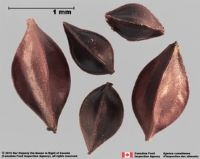 , or schizocarpschizocarp:
, or schizocarpschizocarp:
usually dry fruit splitting between two or more locules to form distinct, indehiscent, usually one seeded segments; fruit derived from a single, superior or inferior, compound ovary; compare to mericarp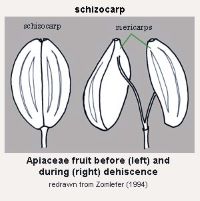 (Platystemon). Fruits 0.2–250 mm long, globoseglobose:
(Platystemon). Fruits 0.2–250 mm long, globoseglobose:
3D shape—more or less spherical to wedge-shapedwedge-shaped:
to wedge-shapedwedge-shaped:
2D shape—triangular and tapering to a point at the base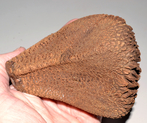 , sometimes toruloseknotted:
, sometimes toruloseknotted:
3D shape—a cylindrical or ellipsoid body that is swollen and constricted at intervals; torulose or moniliformmoniliform:
or moniliformmoniliform:
elongate, relatively slender, transversely round, and more or less regularly constricted over its length, the whole straight or variously curved; like a necklace of beads, see torulose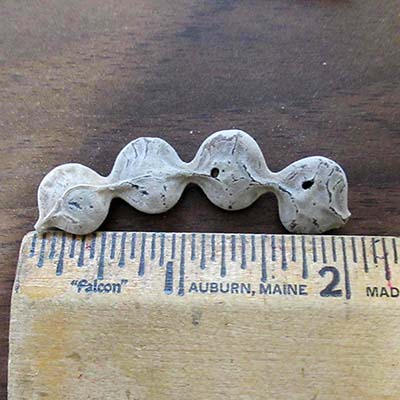 , rarely discoiddiscoid:
, rarely discoiddiscoid:
3D shape—resembling a disc
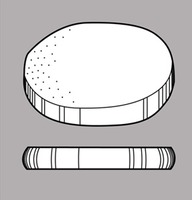 (Discocapnos, acheneachene:
(Discocapnos, acheneachene:
a dry, indehiscent, one-seeded fruit, with seed attached to pericarp at a single point, derived from a single, superior, simple or compound, one-loculed ovary ), straight or curvedcurved:
), straight or curvedcurved:
(of embryo) linear embryo is curved into an arch or horseshoe with the ends far apart to coiledcoiled:
to coiledcoiled:
(of embryo) linear embryo is very long and bent to form a coil whereby one end of the embryo is on the outside and the other end near the middle of the seed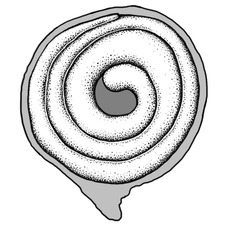 or twisted, usually tereteterete:
or twisted, usually tereteterete:
approximately circular in cross section; width and thickness approximately equal
 or compressedcompressed:
or compressedcompressed:
flattened; in grasses, used to denote compression (not necessarily flattened) either laterally or dorsiventrally
in transection, sometimes flattened or angularangular:
2D shape—having sides that meet at acute or obtuse angles
, stylestyle:
in a flower, the narrow and elongated part of the pistil between the stigma and the ovary; sometimes persisting in fruit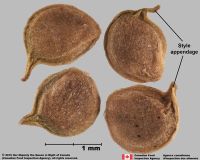 persistent, may form short to long beakbeak:
persistent, may form short to long beakbeak:
a usually firm, terminal appendage, sometimes tapered , rarely with narrow marginalmarginal:
, rarely with narrow marginalmarginal:
at, on, or close to the margin or border
wing (Dactylicapnos spp.), usually with many seeds, except achenes or mericarpsmericarp:
a one-seeded section (carpel) of a schizocarp, as in Apiaceae fruits (compare schizocarp)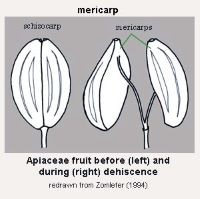 with one seed. Fruits sometimes with 4–18 apicalapical:
with one seed. Fruits sometimes with 4–18 apicalapical:
at or pertaining to the end of the seed or fruit distal from its point of attachment (i.e., base)
opercula. Pericarppericarp:
fruit wall or fruit coat
usually black, brown, or green, more brightly colored in Dactylicapnos, dulldull:
reflecting only a low proportion of incident light, with no apparent sheen , chartaceouschartaceous:
, chartaceouschartaceous:
papery, papyraceous
, rarely leatheryleathery:
texture—moderately thick, tough, and very pliable
, glabrousglabrous:
without hairs
or pubescentpubescent:
surface relief—bearing hairs
, sometimes with pustulatepustular:
surface relief—with small blisters or pustules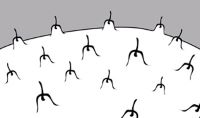 hairs, smooth or sculptured, or with bristles, hornshorn:
hairs, smooth or sculptured, or with bristles, hornshorn:
a straight or curved, slenderly conic or conoidal protrusion, resembling an animal horn
, or spines.
Seeds globoseglobose:
3D shape—more or less spherical to angularangular:
to angularangular:
2D shape—having sides that meet at acute or obtuse angles
, often reniformreniform:
2D or 3D shape—kidney-shaped , sometimes notched, tereteterete:
, sometimes notched, tereteterete:
approximately circular in cross section; width and thickness approximately equal
 to flattened, or angularangular:
to flattened, or angularangular:
2D shape—having sides that meet at acute or obtuse angles
in transection, 0.4–8 mm long. ArilsAril:
(broad sense) appendicular structure that wholly or partly envelops a seed and is produced from or a modification of the funicle, raphe, or outer integument; usually fleshy or pulpy, sometimes spongy or tufted-capillate, often brightly colored or elaiosomeselaiosome:
or elaiosomeselaiosome:
a lipid and protein-rich fleshy structure attached to some seeds and fruits, it attracts ants which then disperse the disseminule (e.g., caruncle in the Euphorbiaceae, the aril (outgrowth of the funiculus) in the Fabaceae)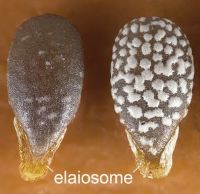 often present, adnate to hilahilum:
often present, adnate to hilahilum:
on seeds, the scar indicating where the funiculus was attached; on grass caryopses, the scar visible on the outer fruit surface revealing where the seed is attached on the inner fruit wall surface; or in Asteraceae cypselae, the scar visible on the outer fruit wall revealing where the fruit was attached to the receptacle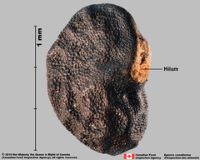 , usually well-developed, white or whitish, rarely yellow, blue, brown, or red or orange-red, fleshy, crested to cup- or cushion-shaped. Some genera with fleshy, white elaiosomeselaiosome:
, usually well-developed, white or whitish, rarely yellow, blue, brown, or red or orange-red, fleshy, crested to cup- or cushion-shaped. Some genera with fleshy, white elaiosomeselaiosome:
a lipid and protein-rich fleshy structure attached to some seeds and fruits, it attracts ants which then disperse the disseminule (e.g., caruncle in the Euphorbiaceae, the aril (outgrowth of the funiculus) in the Fabaceae) . Seed coat brown, black, or white, rarely red or orange (Dicranostigma, Sanguinaria spp.), shinyshiny:
. Seed coat brown, black, or white, rarely red or orange (Dicranostigma, Sanguinaria spp.), shinyshiny:
uniformly reflecting a high proportion of incident light at all angles or dulldull:
or dulldull:
reflecting only a low proportion of incident light, with no apparent sheen , smooth or ribbedribbed:
, smooth or ribbedribbed:
surface relief—wide, prominent, linear ridges that are generally rounded and longitudinally situated on the surface , beakedbeak:
, beakedbeak:
a usually firm, terminal appendage, sometimes tapered , keeledkeel:
, keeledkeel:
a longitudinal ridge, like the keel of a boat, formed by the lengthwise folding of a structure, such as a lemma or palea
 , ornamented, or sometimes spinyspiny:
, ornamented, or sometimes spinyspiny:
having slender, stiff, sharp projections oriented in the general plane of the structure or burlike (Eschscholzia spp.). Hila usually inconspicuous, sometimes punctatepunctate:
or burlike (Eschscholzia spp.). Hila usually inconspicuous, sometimes punctatepunctate:
surface relief—dotted with pits or with translucent, sunken glands or with colored dots, similar to pitted or if larger than punctatepunctate:
or if larger than punctatepunctate:
surface relief—dotted with pits or with translucent, sunken glands or with colored dots, similar to pitted , circularcircular:
, circularcircular:
(of embryo) linear embryo is curved into an "O" shape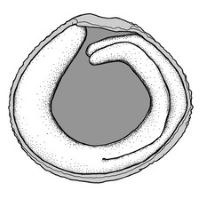 .
.
Embryo well-developed, sometimes rudimentaryrudimentary:
(of embryo) embryo is small and fills less than a quarter of the seed and can be variable in shapes, such as linear, spatulate, or oval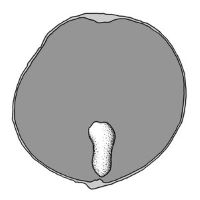 , partially to barely filling seed coat, axileaxile:
, partially to barely filling seed coat, axileaxile:
on or of the axis
and centric, basalbasal:
at or pertaining to the point of attachment; (of embryo) embryo occupies one end of the seed
in Pteridophyllum, linearlinear:
(shape) long, narrow, and uniform in width; (of embryo) embryo is straight and much longer than wide , straight or bentbent:
, straight or bentbent:
(of embryo) embryo is bent at an acute, V-shaped angle with the ends close together and generally thick cotyledons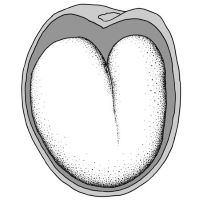 , embedded in endosperm.
, embedded in endosperm.
Endosperm copious, fleshy-watery or fleshy-firm, soft, or crystalline-granular.
| Fruit | |
| Type | capsulecapsule: a dry, dehiscent fruit derived from a compound ovary  , lomentloment: , lomentloment:a usually dry fruit derived from a single carpel that breaks transversely into one-seeded fruit segments, derived from a single, superior, simple ovary  , acheneachene: , acheneachene:a dry, indehiscent, one-seeded fruit, with seed attached to pericarp at a single point, derived from a single, superior, simple or compound, one-loculed ovary  , schizocarpschizocarp: , schizocarpschizocarp:usually dry fruit splitting between two or more locules to form distinct, indehiscent, usually one seeded segments; fruit derived from a single, superior or inferior, compound ovary; compare to mericarp  |
| Size range | 0.2–250 mm long |
| Shape(s) | globoseglobose: 3D shape—more or less spherical  , ellipsoidellipsoid: , ellipsoidellipsoid:3D shape—elliptic , linearlinear: (shape) long, narrow, and uniform in width; (of embryo) embryo is straight and much longer than wide  , fusiformfusiform: , fusiformfusiform:spindle-shaped; broadest at the middle and tapering at both ends 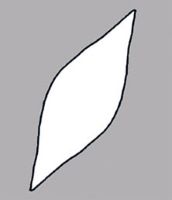 , cylindricalcylindrical: , cylindricalcylindrical:3D shape—a cylinder, with parallel sides and a circular cross-section; tubular or rod-shaped , oblongoblong: 2D shape—much longer than broad with nearly parallel sides, corners are rounded  , ovoidovoid: , ovoidovoid:3D shape—ovate  , lanceoloidlanceoloid: , lanceoloidlanceoloid:3D shape—lanceolate , conicalconical: 3D shape—cone-shaped, with the point of attachment at the broad end 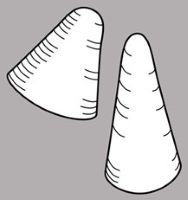 , wedge-shapedwedge-shaped: , wedge-shapedwedge-shaped:2D shape—triangular and tapering to a point at the base  , obcordiform, sometimes toruloseknotted: , obcordiform, sometimes toruloseknotted:3D shape—a cylindrical or ellipsoid body that is swollen and constricted at intervals; torulose  or moniliformmoniliform: or moniliformmoniliform:elongate, relatively slender, transversely round, and more or less regularly constricted over its length, the whole straight or variously curved; like a necklace of beads, see torulose  , rarely discoiddiscoid: , rarely discoiddiscoid:3D shape—resembling a disc  (Discocapnos, acheneachene: (Discocapnos, acheneachene:a dry, indehiscent, one-seeded fruit, with seed attached to pericarp at a single point, derived from a single, superior, simple or compound, one-loculed ovary  ), straight or curvedcurved: ), straight or curvedcurved:(of embryo) linear embryo is curved into an arch or horseshoe with the ends far apart  to coiledcoiled: to coiledcoiled:(of embryo) linear embryo is very long and bent to form a coil whereby one end of the embryo is on the outside and the other end near the middle of the seed  or twisted or twisted |
| Texture | chartaceouschartaceous: papery, papyraceous , rarely leatheryleathery: texture—moderately thick, tough, and very pliable |
| Surface relief | smooth, ribbedribbed: surface relief—wide, prominent, linear ridges that are generally rounded and longitudinally situated on the surface  , groovedgrooved: , groovedgrooved:surface relief—linear depressions that may be single or form a series of grooves over the surface 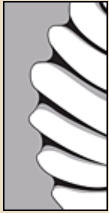 , papillosepapillate: , papillosepapillate:surface relief—bearing minute, distinct, broad-based projections, tapering to a rounded apex  , reticulatereticulate: , reticulatereticulate:surface relief—netted, raised walls or concave grooves forming a net-like surface pattern with flat, concave, or convex interspaces  , striatestriate: , striatestriate:surface relief—having fine, parallel lines, grooves or ridges  , wrinkledwrinkled: , wrinkledwrinkled:surface relief—shallow, irregular folds and furrows covering the surface; appearing overall though crumpled and then spread out  , wartywarty: , wartywarty:surface relief—distinct, rounded projections that are large relative to the fruit size; tuberculate, verrucose  , pebbled, or with bristles, hornshorn: , pebbled, or with bristles, hornshorn:a straight or curved, slenderly conic or conoidal protrusion, resembling an animal horn , or spines |
| Color(s) | black, brown, or green, except in Dactylicapnos also purple, red, yellow or whitish |
| Unique features | Usually dulldull: reflecting only a low proportion of incident light, with no apparent sheen  , capsular fruit with valvate, poricidalporicidal: , capsular fruit with valvate, poricidalporicidal:type of capsular dehiscence, fruit opening by pores or flaps (often near the top)  , or transversetransverse: , or transversetransverse:lying, situated, or placed across dehiscence, sometimes explosively dehiscentdehiscent: (v. dehisce) splitting open at maturity to release contents (of a fruit) 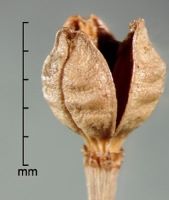 , beakedbeak: , beakedbeak:a usually firm, terminal appendage, sometimes tapered  , and often with numerous, conspicuously ornamented tiny seeds with copious endosperm. , and often with numerous, conspicuously ornamented tiny seeds with copious endosperm. |
| Seed | |
| Size range | 0.4–8 mm long |
| Shape(s) | globoseglobose: 3D shape—more or less spherical  , ellipsoidellipsoid: , ellipsoidellipsoid:3D shape—elliptic , ovoidovoid: 3D shape—ovate  , falcatefalcate: , falcatefalcate:shaped like a scythe or sickle  , lens-shapedlens-shaped: , lens-shapedlens-shaped:2D shape—round and flattened with two curved (convex) surfaces , pear-shaped, reniformreniform: 2D or 3D shape—kidney-shaped  , C-shapedC-shaped: , C-shapedC-shaped:2D-shape—semiannulate, curved into the shape of the letter 'C' , D-shapedD-shaped: 2D shape—has one straight margin and one curved margin, resembling the shape of the letter D , angularangular: 2D shape—having sides that meet at acute or obtuse angles |
| Surface relief | smooth, ribbedribbed: surface relief—wide, prominent, linear ridges that are generally rounded and longitudinally situated on the surface  , striatestriate: , striatestriate:surface relief—having fine, parallel lines, grooves or ridges  , keeledkeel: , keeledkeel:a longitudinal ridge, like the keel of a boat, formed by the lengthwise folding of a structure, such as a lemma or palea  , beakedbeak: , beakedbeak:a usually firm, terminal appendage, sometimes tapered  , pittedpitted: , pittedpitted:surface relief—surface with small depressions in which the areas between the hollows do not take on the appearance of a true reticular net  , bubbled, wartywarty: , bubbled, wartywarty:surface relief—distinct, rounded projections that are large relative to the fruit size; tuberculate, verrucose  , reticulatereticulate: , reticulatereticulate:surface relief—netted, raised walls or concave grooves forming a net-like surface pattern with flat, concave, or convex interspaces  , alveolatealveolate: , alveolatealveolate:surface relief—reticulated, honeycombed; ridges that intersect to form polygonal cells with a regular size and shape similar to a honeycomb  , tessellate, papillosepapillate: , tessellate, papillosepapillate:surface relief—bearing minute, distinct, broad-based projections, tapering to a rounded apex  , spinyspiny: , spinyspiny:having slender, stiff, sharp projections oriented in the general plane of the structure  , or burlike (Eschscholzia spp.) , or burlike (Eschscholzia spp.) |
| Color(s) | brown, black, white, rarely red or orange |
| Unique features | Usually small, arillate seeds conspicuously ridgedridged: surface relief—raised, thick ridges, sharp edged or rounded, usually in a series that may cover the entire surface 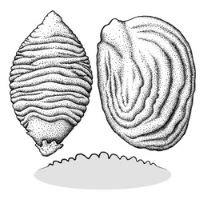 with smooth or with regular netlike sculpturing. Embryos more than half the length of the seeds and embedded in copious fleshy or granulargranular: with smooth or with regular netlike sculpturing. Embryos more than half the length of the seeds and embedded in copious fleshy or granulargranular:surface relief—having a grainy surface 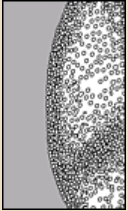 endosperm. endosperm. |
| Other | |
| Embryo | well-developed, sometimes rudimentaryrudimentary: (of embryo) embryo is small and fills less than a quarter of the seed and can be variable in shapes, such as linear, spatulate, or oval  , partially to barely filling seed coat , axileaxile: , partially to barely filling seed coat , axileaxile:on or of the axis and centric, basalbasal: at or pertaining to the point of attachment; (of embryo) embryo occupies one end of the seed in Pteridophyllum, linearlinear: (shape) long, narrow, and uniform in width; (of embryo) embryo is straight and much longer than wide  , straight or bentbent: , straight or bentbent:(of embryo) embryo is bent at an acute, V-shaped angle with the ends close together and generally thick cotyledons  , embedded in endosperm , embedded in endosperm |
| Nutritive tissue | endosperm copious, fleshy-watery or -firm, soft, or crystalline- granulargranular: surface relief—having a grainy surface  |
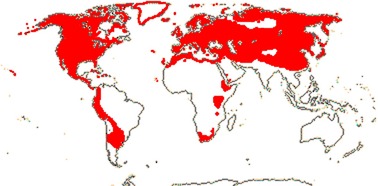
Distribution map courtesy of Angiosperm Phylogeny Website.
Flora of North America Editorial Committee 1993+Flora of North America Editorial Committee 1993+:
Flora of North America Editorial Committee, eds. 1993+. Flora of North America North of Mexico [Online]. 22+ vols. Flora of North America Association, New York and Oxford. Accessed January-March 2024. URL: http://beta.floranorthamerica.org.; Kirkbride et al. 2006Kirkbride et al. 2006:
Kirkbride JH, Jr, Gunn CR, and Dallwitz MJ. 2006. Family guide for fruits and seeds, vers. 1.0. Accessed September 2020-January 2022. URL: https://nt.ars-grin.gov/seedsfruits/keys/frsdfam/index.cfm .; Kubitzki et al. 1990+Kubitzki et al. 1990+:
Kubitzki K et al., eds. 1990+. The families and genera of vascular plants. 7+ vols. Berlin etc.; Takhtajan 2009Takhtajan 2009:
Takhtajan A. 2009. Flowering plants: Second edition. Springer Nature, Switzerland. 871 pp.; USDA 1980USDA 1980:
United States Dept. of Agriculture (USDA). 1980. Major weed family identification guide. Hyattsville Md, United States ; Zhengyi et al. 2004+Zhengyi et al. 2004+:
Zhengyi W, Raven PH, and Deyuan H. 2004+. Flora of China [online]. 25 vols. Science Press, Beijing China & Missouri Botanical Garden, St. Louis USA. Accessed January–March 2024. http://flora.huh.harvard.edu/china/
*The number of genera and species is based on Christenhusz and Byng 2016Christenhusz and Byng 2016:
Christenhusz MJM and Byng JW. 2016. The number of known plant species in the world and its annual increase. Phytotaxa 261 (3): 201-217. https://doi.org/10.11646/phytotaxa.261.3.1, which may differ from the number of genera in GRIN-Global.